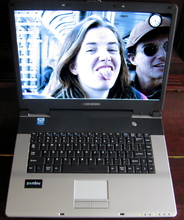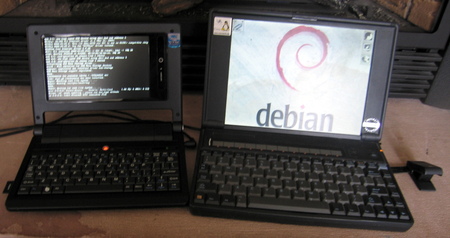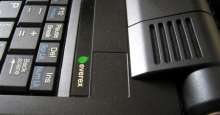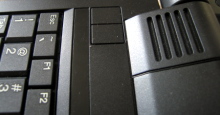Review: Zonbu Zonbook and gOS Cloudbook
Mar 19, 2008 — by LinuxDevices Staff — from the LinuxDevices Archive — 16 views Foreword — This hands-on review compares and contrasts two computing appliances that run Linux on Via C7-M processors. The Zonbu Zonbook and the gOS Cloudbook are both manufactured by Everex, and cost about the same up-front, but that's where the resemblances end, our reviewer found.
Foreword — This hands-on review compares and contrasts two computing appliances that run Linux on Via C7-M processors. The Zonbu Zonbook and the gOS Cloudbook are both manufactured by Everex, and cost about the same up-front, but that's where the resemblances end, our reviewer found.
by Henry Kingman
I recently had the opportunity to try out two very different laptop-like computing appliances, both based on Via C7-M processors and priced around $400. The Zonbu Laptop proved to be one of the most civilized, well-behaved Linux systems I have ever used, while the gOS Cloudbook was a real handful, despite its tiny size.
The Zonbook
 “I'm better than your Linux box,” the Zonbook seems to say (Click to enlarge) |
The Zonbu Laptop is a generously sized yet fairly lightweight machine with a large, 15.4-inch widescreen format display. It runs a managed Linux OS with a full complement of open source application software. By “managed,” I mean that the OS updates itself in the background from time to time. It also backs up the user's files to Amazon's S3 web service, although the user need not be aware of that detail. Online storage, backups, and updates come with a monthly subscription fee.
Most everything about the Zonbu “just works,” which is almost dismaying to someone like me with a decade's experience fiddling around with laptops to try to get everything working under Linux. The kids of today simply are not going to understand what it took, back in the day, to get for example sound working in your HP Omnibook 800CT (more about that, later).
With the Zonbu, you plug in your printer — it works. Your digital camera that has never worked with any computer — it works. The network DLNA media server — works. Rhapsody for Firefox — works. iPod — depending on the model, and how aggressively Apple crippled it — even that may work.
I did have to compile a kernel module to get NFS access to the network file server, but the process was well-documented and easy. Disappointingly easy, actually.
Even the hard-to-get-right parts, like ACPI power management, seem perfect to me, unless you count sometimes having to run the WiFi connect wizard when the machine is suspended for longer than its DHCP lease. But that's certainly a niggle. I especially like the way the machine suspends itself to disk when the battery starts to get dangerously low. Nice.
The folks at Zonbu have good taste in open source software, and I like the pre-load that they came up with. They don't honor applications' real names, but you're getting the good stuff here, for the most part:
- Internet — Firefox, Evolution, Pidgin, Skype, P2P/BitTorrent
- Office — Acrobat Reader, GnuCash personal finance manager, and OpenOffice.org office suite (including database and math components)
- Multimedia — Banshee, mplayer, f-spot
- Publishing — GimpShop, Scribus desktop publisher, Nvu web page editor
- Games — Supertux, Tiltball, Tron, Breakout, Frozen Bubble, Penguins, Pingus, Tetris, Chess, Crossword Puzzles, Solitaire, Sodoku, Swap Attach, Blobwars, Chromium, Billiards, Civilization, Ataxx, Five or More, Four in a Row, Iagno, Klotski, Mahjongg, Mines, Nibbles, Robots, Same GNOME, Tali, Tetravex
And, the good stuff doesn't end where the command line starts. I knew I was in love when I discovered that imagemagick was there. I use imagemagick's commandline “convert” utility all the time to resize, rotate, and re-sample images in batches much faster than any graphical program like Photoshop could do it.
I've used the Zonbook that Zonbu sent me on and off for about four months. I've used it to edit LinuxDevices.com. I've used it to take notes in board meetings. I've used it to run slideshows off the NAS and print photos on the network printer for guests. I've brought it into the kitchen to stream music from the NAS. I've watched YouTube videos and played DVDs on it. It always just works. I'm embarrassed to admit that at times, it has worked better than the Debian laptops that I've carefully “tuned” through many patient hours.
I guess I've held off writing the review for so long, hoping to find a serious nit or two to pick. I have not been able to do it. It's as perfect a machine as computers get here in the “model T” era of desktop computing (which I personally happen to believe we're still in).
I have noticed a few forum threads where people complain of things like specific printer support breaking after an automated upgrade, and that isn't really surprising. But it has not been my mileage. I've seen a steady, almost frighteningly good progression of improvements, one after the other. The pace of improvement in open source software has always been exhilarating, and never more-so than when there's absolutely no effort involved in enjoying the rising tide.
Which leads me to my prediction.
Zonbu is way too good at what they are doing to last. They may well be delivering the best desktop experience available today. Something will go wrong. Someone will buy them, and kill them off. Google will hire all their key people. Microsoft will buy out their investors. Apple will sue them for supporting the iPod. But it can't last. They're that good.
More details about the Zonbu Zonbook, including specifications, pricing model, and more photos, can be found in our earlier coverage, here.
Cloudbook slash Nanobook
And then there's the Everex Cloudbook, one of the first available “UMPCs” (ultra-mobile PCs). The hardware itself is based on Via's beguiling “Nanobook” reference design. The pre-installed OS is “gOS,” famously used on the $200 Wal*Mart PCs from Everex.
Playing around with the Cloudbook for a few days took me back to the rough and tumble edges of the Linux frontier in a hurry. As noted, it's one of the first devices in an entirely new class of computing product, so it's not too surprising that there are some sharp, protruding metal edges (figuratively speaking). In fact, with its tiny form factor and unusual pointing device, the Cloudbook reminded me of nothing so much as my old 800CT, purchased new but on closeout in 1998 as a platform for Linux fun and experimentation.

The Cloudbook (left) and 800ct, with “paw” pointing device and full-sized keyboard
(Click to enlarge)
The 800ct was among the most highly integrated computing devices of its day. It was also the last HP laptop designed in the U.S., according to rumor. Driven by a Pentium P166MMX, its Neomagic chipset offered 2MB of video RAM, although a couple hundred K of that never seemed quite usable. The IDE controller had quirky DMA, to say the least. The laughably labeled “100 percent SoundBlaster compatible” DSP would wrestle any other peripheral for its IRQ, if given half a chance, and it had a half-sized buffer. And then there was the SCSI interface. Oh, my.
Running Linux 2.0, 2.2, and 2.4 kernels, and Debian Slink, Potato, and Sid, the 800CT has pretty much been a complete pain. But in a good way. The device itself is somehow captivating, small and cuddly, and with an honest-to-gosh thin-film transistor LCD. The odd pop-out mouse, aka “the paw,” was kind of like holding a child's tiny hand. And it was so exhilarating when you finally built a kernel that coaxed some low-quality 16-bit audio out! Or when you got APM suspend-to-RAM figured out (you have to pull the power cord before hitting 'apm -s'). Or when you made the tiny laptop drive some massive SCSI peripheral of that era, like a Nikon slide scanner.
So, what does any of this have to do with the Cloudbook? Well, as delivered, the Cloudbook is pretty much a complete pain. The 1.2GHz processor struggles mightily to load the weighty fake Max OS X graphical environment of gOS. No customization appears to have been done for the relatively constrained 800×480 display. None of the installed applications support the webcam. Power management is very aggressive, and any activity at all, like scrolling a web page, makes the fan pick up speed. The air intake is located on the bottom, so the device will actually vacuum your carpet at the same time that it's overheating. I could go on.
But at the same time, there are enough cuddly features here to inspire endless hours of creative tinkering. For starters, there's a full-sized SD card slot attached via USB, enabling the BIOS to detect and load bootable media in it. That alone gives this little darling endless potential.
The symmetrically placed built-in stereo speakers and HD audio are light years beyond “100 percent SoundBlaster compatible.” The battery is fairly large, considering the modest power requirements. The keyboard, though small, is touch-type-able, and therefore 10 times faster (for an old fogie like me, anyway) than something like a Nokia N810 with a thumb keyboard. And of course, there's the split pointing device, with a thumbpad on the right, and two thumb buttons on the left. Personally, I like it (but then, I also liked “the paw”), especially when couch-surfing.


Cloudbook's unique split trackpad
(Click to enlarge)
If I were 32 again, and thus better able to survive multiple sleepness nights of hacking in a row, I'd probably find myself completely engrossed by the Cloudbook. I'd build a streamlined, fast-booting kernel for it. I'd get Debian onto it. I'd install motion and a webserver, and turn it into a portable motion-detecting security camera that'd text my mobile phone if the cat jumped up onto the sink. I'd install f-spot, and get a solar charger, and use it as a digital photo wallet and hotspot email pad on bicycle tours. I'd install Firefox, and use it to control my mpd-based stereo at home. I'd hook it up to a T-amp and some efficient full-range speakers and use it to stream music out on the back porch. Using its DVI out port with a high-quality LCD flat panel display, I'd use it for dynamic website development, writing, editing, and all the same things I'd have used any PC for, back then.
As available curently, the Cloudbook isn't so much a tool as a toolbox. There's lots to like about it, but the promise lies more in potential that actualized reality. Still, some future iteration of the Cloudbook could be a blockbuster product capable of competing with top-of-class devices like the Asus EEE PC, which as I write this is number one on Amazon.com's top 25 best-selling computer and PC hardware products.
The UMPC market certainly has appeal. The Via Nanobook design is quirky and appealing. It just needs some hacker love. Meanwhile, Everex has hinted at a “Developer” version, possibly with a touchscreen. Maybe it will even use Via's next-generation 64-bit Isaiah processor — who knows? The UMPC market is just beginning, and there's lots of exciting times (and late night compiles) ahead.
More details about the Cloudbook, including its specifications and better photos, can be found in our previous coverage, here.
 About the author — Henry Kingman is the executive editor of Ziff Davis Enterprise's DeviceForge group. He has loved impractically small computers with weird pointing devices ever since 1998, when he bought an Omnibook 800CT on closeout for $1,000, less than half its original price.
About the author — Henry Kingman is the executive editor of Ziff Davis Enterprise's DeviceForge group. He has loved impractically small computers with weird pointing devices ever since 1998, when he bought an Omnibook 800CT on closeout for $1,000, less than half its original price.
This article was originally published on LinuxDevices.com and has been donated to the open source community by QuinStreet Inc. Please visit LinuxToday.com for up-to-date news and articles about Linux and open source.